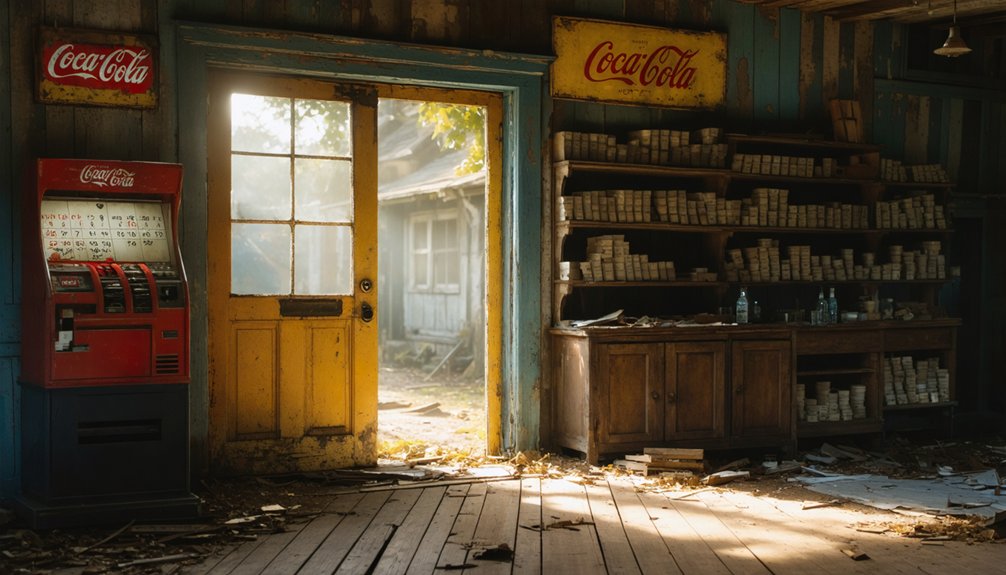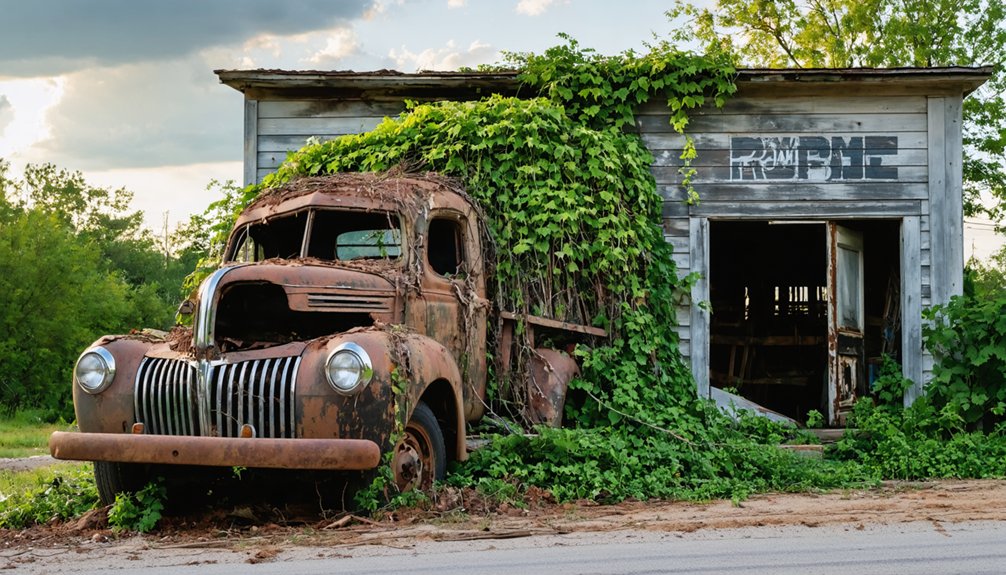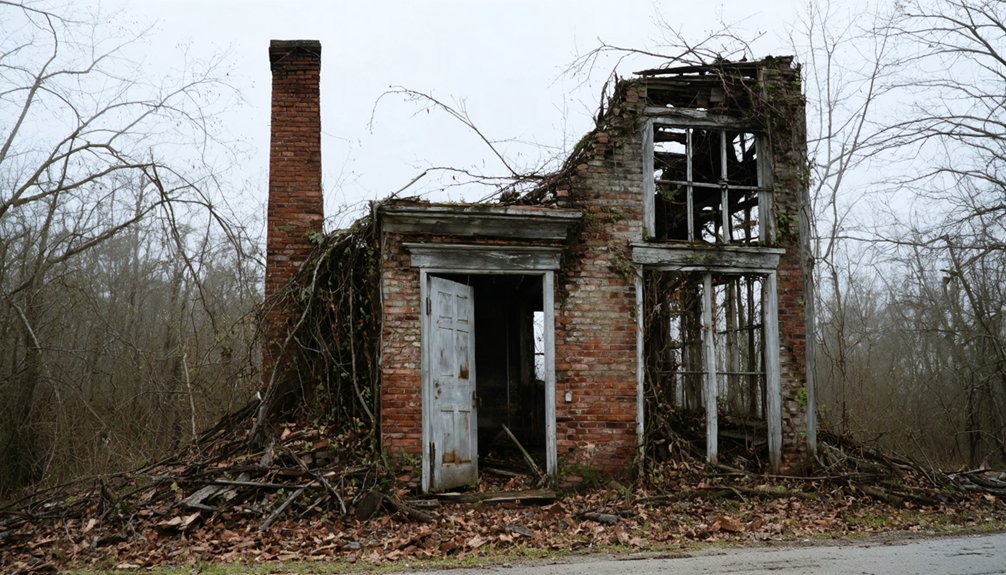You’ll find Pikeville ghost town in northwestern Alabama’s Marion County, where it served as the county seat from 1820 to 1883. The abandoned settlement features the original courthouse, Judge Terrell’s historic home, and a civil war cemetery with an unknown War of 1812 soldier’s tomb. Local supernatural tales include unexplained phenomena around forgotten burial grounds and playgrounds. Today, this haunting reminder of pioneer life offers a fascinating glimpse into Alabama’s rural heritage and untold stories.
Key Takeaways
- Pikeville was established in 1818 and served as Marion County’s seat until 1882, when its decline into a ghost town began.
- The historic courthouse remains the only major surviving structure from Pikeville’s prime, featuring Federal-era architecture and original heart-of-pine walls.
- Supernatural occurrences are reported around abandoned buildings, burial grounds, and playgrounds, including ghostly laughter and unexplained footsteps.
- The site includes the Terrell family home, a civil war cemetery, and the tomb of an unknown War of 1812 soldier.
- Economic challenges, poor soil conditions, and the courthouse’s relocation to Hamilton in 1883 led to Pikeville’s abandonment.
The Rise and Fall of a County Seat
When Marion County was first established in 1818 from Chickasaw treaty lands, Pikeville emerged as its crucial administrative center. After brief temporary locations, you’d find the county’s permanent seat established here in 1820, with official incorporation following in 1827.
The town became a hub for community gatherings and judicial significance, serving a vast territory that included parts of modern Alabama and Mississippi. Early settlers came from nearby Southern states including Tennessee, Kentucky, Georgia and the Carolinas.
Despite its administrative importance and strategic location near essential trade routes like the Military Road, Pikeville remained modest in size with just 15 businesses and a few dozen homes. The town was particularly known for its leather tanning operations, which included the production of shoes and saddles.
Historic Architecture and Preserved Landmarks
When you visit Pikeville today, you’ll find Judge Terrell’s historic home and family cemetery situated along Jackson’s Military Road, marking the residence of one of the town’s most prominent families.
The courthouse, representing early 19th-century public architecture, stands as the only major surviving structure from Pikeville’s heyday as a county seat. Similar to Fort Mims site, the area holds deep historical significance in Alabama’s development.
While most of the town’s original buildings have vanished, these preserved landmarks offer you a glimpse into the architectural heritage and civic importance of this once-thriving community. Like many settlements established in Bibb County 1818, Pikeville represents an important chapter in early Alabama history.
Judge Terrell’s Historic Home
Standing as one of Pikeville’s few remaining Antebellum structures, Judge John Dabney Terrell Jr.’s historic home began its life in the 1820s as Marion County’s third courthouse before its 1859 conversion into a private residence.
You’ll find foot-wide heart-of-pine walls throughout this two-story building, which remains remarkably preserved in its original character under continuous Terrell family ownership. The property features a distinctive two-story front porch facing east and is located along Jackson’s Military Road, offering a direct connection to early American transportation routes.
The home’s judicial legacy lives on through preserved courthouse benches from early court sessions and period artifacts from the 19th century.
While Pikeville itself stands abandoned, this historic landmark continues to draw history enthusiasts interested in exploring Alabama’s territorial past.
Alongside ancient graveyards, War of 1812 soldier tombs, and segments of Jackson’s Military Road, it’s a reflection of Marion County’s rich early history.
Preserved Courthouse Features
The architectural legacy of Pikeville’s historic courthouse-turned-residence endures through its remarkably preserved Federal-era features.
You’ll find the building’s courthouse preservation most evident in its original two-story layout, complete with the central hallway typical of early 19th-century civic structures. The hand-hewn heart-of-pine walls, measuring a foot wide, showcase rare old-growth Southern timber construction. Similar to the two-story brick design of Pike County’s fourth courthouse, this historic building exemplifies enduring architectural traditions. Like the National Register status of Autauga County’s courthouse, this structure stands as a testament to Alabama’s architectural heritage.
What makes this site’s architectural significance truly exceptional are the original courthouse benches still in place, among the few surviving examples in Alabama.
The heavy timber framing, wide plank floors, and substantial fireplaces remain untouched, while the windows and doors maintain their historic proportions.
Even after its 1859 conversion to a private residence, the structure’s unmistakable civic character shines through its authentic Federal-style brickwork.
Life in Early Marion County
As a pioneer in early Marion County, you’d face the daily challenges of carving out a living from largely undeveloped land that initially sold for just $1-$10 per acre.
Most early inhabitants were among the 1,000 pioneer settlers who established the first communities before the county’s official creation in 1818.
You’d rely heavily on horseback and wagon travel along Andrew Jackson’s Military Road, which served as the main artery connecting scattered homesteads to crucial trading posts.
This region was one of multiple Marion Counties established across the United States during the pioneering era.
Local commerce centered around small establishments like those run by Col. Brock and Dutch Phillip, where you could trade agricultural goods and purchase essential supplies needed for frontier survival.
Pioneer Settlement Challenges
During the winter of 1817-1818, pioneer settlers from Tennessee, Kentucky, Georgia, and the Carolinas faced formidable obstacles while establishing their new lives in what would become Marion County.
You’d have witnessed these determined pioneers tackling harsh environmental challenges as they adapted to unfamiliar terrain and climate. The lack of infrastructure meant you’d need to forge paths through dense forests and navigate geographical barriers.
Settlement adaptation required careful negotiation with Chickasaw tribes while establishing sustainable farming practices in untested soil. Economic hardships were constant companions – you couldn’t just walk to a store; trade with Native Americans and fellow settlers became essential for survival.
Without formal education systems or established religious institutions, you’d rely on community bonds and shared knowledge to overcome pioneer hardships.
Daily Transportation Methods
Moving beyond pioneer hardships, transportation networks shaped daily life in early Marion County through interconnected pathways of commerce and communication.
You’d find yourself relying heavily on horseback travel along General Jackson’s Military Road, which served as the primary artery connecting Nashville to New Orleans through Pikeville. For heavier loads, wagon transport proved essential, though you’d need to carefully navigate the unpaved terrain to avoid getting stuck.
Your daily movements would follow ancient Indian trails, now improved for mail delivery and trade. While nearby rivers offered seasonal shipping options, you’d typically depend on horses and oxen-drawn conveyances to move goods between settlements.
The Military Road’s strategic placement through Pikeville cemented the town’s early importance as a hub of regional commerce.
Local Trade Networks
While native tribes had long established trade routes through Marion County, the arrival of settlers in the early 1800s transformed local commerce through a blend of traditional and new trading networks.
You’d find bustling trade centers like Cotton Gin Port and Bear Creek where settlers exchanged cotton, corn, and pork with both natives and merchants. Local barter systems thrived as communities grew around general stores and trading posts.
If you lived in early Marion County, you’d likely trade at Col. Brock’s mercantile or similar establishments, where goods from Tennessee and Mobile flowed along Gaines’ Trace.
The most successful traders positioned themselves near water routes and Indian trading houses, creating essential commercial hubs that served settlers within a day’s journey of these centers.
Tales of the Supernatural
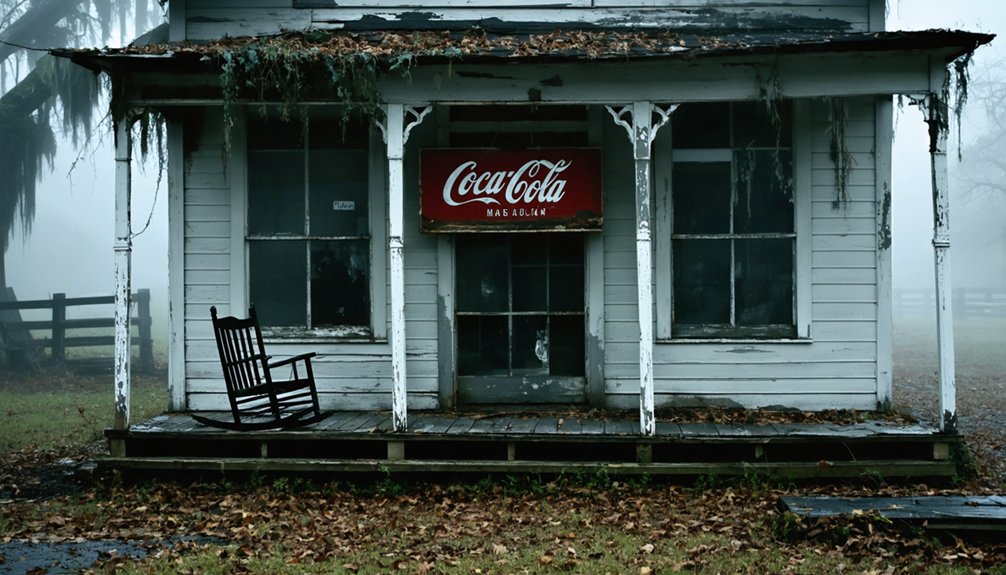
Like many abandoned communities across Alabama, Pikeville harbors a rich tapestry of supernatural tales that have become deeply woven into local folklore.
Pikeville’s ghost stories echo through time, joining countless other abandoned Alabama towns in their haunting dance with the supernatural.
You’ll encounter some of the most compelling paranormal activity around the area’s forgotten burial grounds and playgrounds, where ghostly laughter echoes through the night air. Witness swings moving on their own and flashlights mysteriously failing as unseen children seem to continue their eternal play.
The town’s haunted structures tell their own stories through unexplained footsteps, apparitions in period clothing, and the infamous cold spots that mark spiritual presence.
You might experience doors opening by themselves or feel an unseen touch on your shoulder. These phenomena connect Pikeville to Alabama’s broader supernatural heritage, where tragedy and mystery often intertwine with local history.
Economic Changes and Population Shifts
Because Pikeville lost its status as Marion County’s seat in 1882, the once-promising settlement experienced a swift economic decline that would ultimately seal its fate.
You’ll find that the town’s economic struggles were rooted in its agricultural limitations and poor soil conditions, which had already restricted growth even during its peak of roughly 20-30 homes.
When the county courthouse moved to nearby Hamilton in 1883, Pikeville’s remaining businesses and residents soon followed.
The settlement’s population decline accelerated as families sought better opportunities elsewhere.
While Marion County’s other towns eventually benefited from timber industry growth and improved transportation networks in the mid-20th century, Pikeville never recovered.
Its transformation from a modest village to a ghost town reflects the harsh realities of rural economic change in Alabama.
Exploring the Ghost Town Today
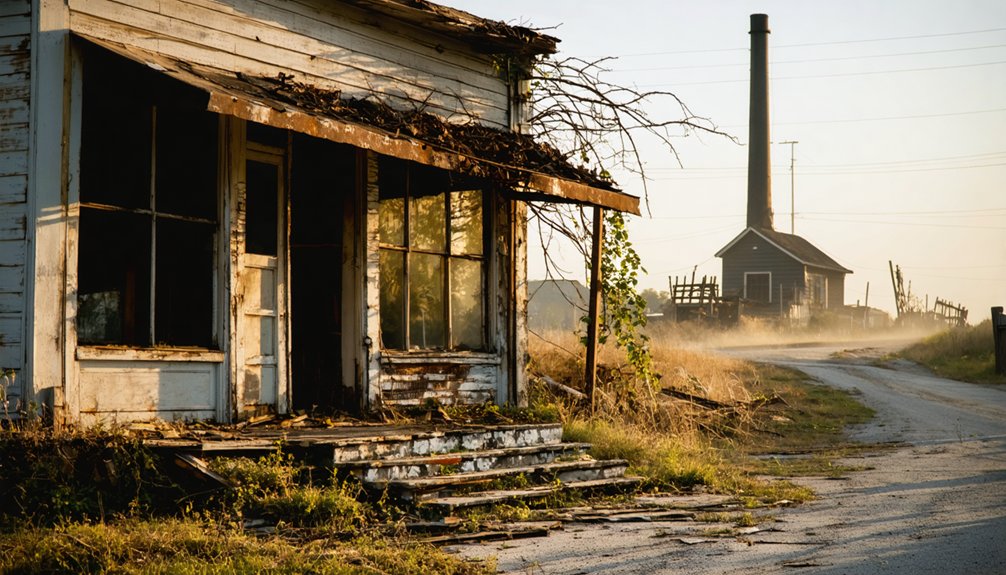
Today’s visitors to Pikeville can explore several remarkable historical landmarks that have survived the settlement’s decline.
You’ll find the centerpiece of your ghost town exploration at the two-story Terrell family home, which once served as the Marion County Courthouse. Inside, you can see the original courthouse benches and impressive foot-wide heart-of-pine walls that showcase antebellum craftsmanship.
Visitors marvel at the historic Terrell home’s transformation from courthouse to museum, featuring original benches and stunning heart-of-pine architecture.
Just a mile south, you’ll discover a civil war cemetery and the tomb of an unknown War of 1812 soldier, adding to the historical landmark significance of the area.
The site’s proximity to Jackson’s Military Road and its natural setting make it perfect for combining historical research with outdoor activities.
While exploring, you’ll appreciate how the community has preserved these treasures of Alabama’s past.
Preserving Alabama’s Rural Heritage
Through systematic efforts spanning more than a decade, the Alabama Historical Commission has established itself as a driving force in preserving the state’s rural heritage.
You’ll find their heritage conservation work reflected in the nomination of over 4,300 properties to the National Register and the protection of more than 2,200 properties through local historic districts.
They’ve made rural preservation more accessible by digitizing 120,000+ historic documents and creating online GIS portals for public use.
If you’re interested in protecting historic properties, you can tap into preservation tax credits, reduced-match grants, and technical support through partnerships with major universities.
The commission’s collaboration with the Black Heritage Council guarantees inclusive documentation of under-represented communities, while partnerships with conservation programs help protect both historic and natural landscapes across rural Alabama.
Frequently Asked Questions
Are There Guided Tours Available of the Pikeville Ghost Town Site?
You won’t find guided ghost tours at this site – there’s no official tour program in place, despite its historical significance. You’ll need to explore the area independently.
What Is the Best Time of Year to Visit Pikeville?
You’ll find the best weather and most comfortable exploring conditions in fall (October-November) when temperatures are mild, insects are fewer, and nature’s autumn colors enhance your outdoor walking experience.
Is Special Permission Required to Visit Judge Terrell’s Home?
Like many historical treasures guarded by local legends, you’ll need to obtain permission to visit Judge Terrell’s home since it remains private property owned by the Terrell family, despite its significant courthouse heritage.
How Long Does It Typically Take to Explore the Entire Site?
You’ll need about 1-3 hours to thoroughly explore the site, depending on accessibility and your interests. The main areas can be covered in an hour if you’re moving at a steady pace.
Are There Any Nearby Accommodations for Overnight Ghost Town Visitors?
While there aren’t camping options right at Pikeville, you’ll find basic local inns in Guin and Hamilton, just 10-15 miles away. Days Inn and Relax Inn offer straightforward, budget-friendly stays.
References
- https://www.marioncountyal.org/Default.asp?ID=428&pg=County+History
- https://digitalalabama.com/alabama-ghost-towns/alabama-ghost-towns/9449
- https://ahc.alabama.gov/properties/cahawba/cahawba.aspx
- https://www.onlyinyourstate.com/trip-ideas/alabama/ghost-towns-road-trip-al
- https://www.youtube.com/watch?v=vdwMgelc4SA
- https://www.hmdb.org/m.asp?m=96485
- https://encyclopediaofalabama.org/article/marion-county/
- https://en.wikipedia.org/wiki/Pikeville
- https://kids.kiddle.co/Marion_County
- https://www.hamiltoncityal.org/About/History
